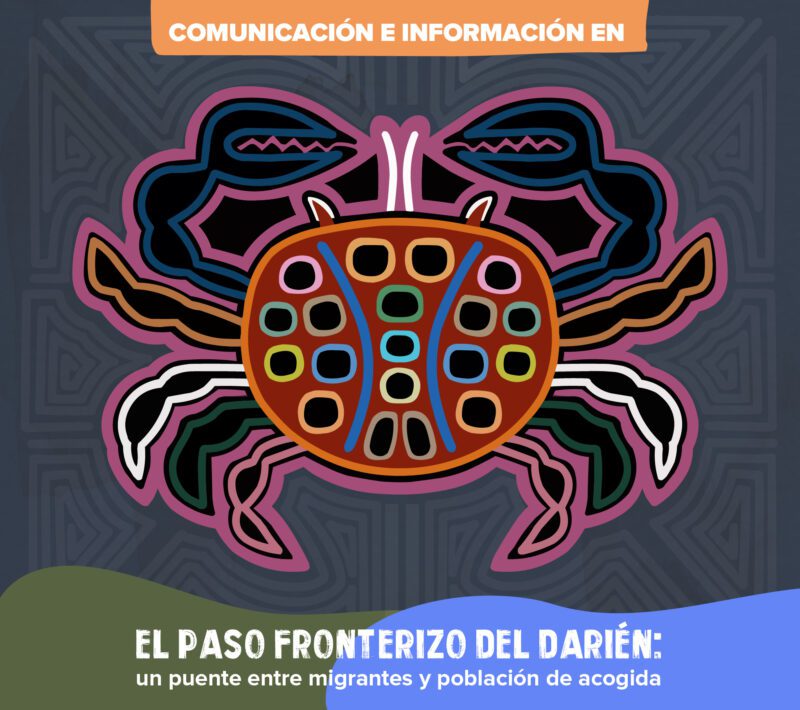Investigating how the information ecosystem operates in the Darién Gap border region is crucial—not only because communication processes reveal historical gaps and structural voids in the region, but also because useful and effective communication spaces can respond to the diverse circumstances these populations face in humanitarian crisis.
This research shows the relationship of migrant and host populations in the Darién Gap (on the Colombian side of the border) with media and information channels, as well as the latter’s contribution to the affected population’s most immediate needs. This report is the result of a project developed in alliance with Sinergias – Alianzas Estratégicas para la Salud y el Desarrollo Social, SentARTE – arte con sentido, and Internews. The project sought to generate information tools to respond to the mental health crisis exacerbated by COVID-19 and migration and took place from June to September 2023 in the Darién Gap region (specifically in the Necoclí, Acandí, and Capurganá regions).
The research methodology consisted of an observational cross-sectional, mix-method study, carried out in three parallel stages: review of secondary data on actors and information related to migration; a qualitative process that included 15 semi-structured interviews and five focus groups including the migrant and host populations, as well as at official institutions and organizations present in the towns of Necoclí, Acandí and Capurganá. Finally, the methodology included a survey distributed to the migrant and host populations, which garnered 170 responses.
Some of the Key findings include:
The main information needs of the migrant population are related to their transit through the Darién. Topics such as weather forecasts, necessary elements for their migratory journey, and the amount of money required to cover the expenses of the travels stood out in the responses.
The migrant and host populations are interested in various topics, including staying in touch with family and friends (79%), obtaining information about their country of origin (75%), staying informed about news in general (72%), and seeking humanitarian and migration-related information (65%).
If you want to read other findings, recommendations, and specific information needs, we invite you to read the full document and its summary. But above all to use the findings and recommendations to create more effective content and channels for both communities. The Center for Disaster Philanthropy (CDP) supported this research.
Examining the Information Needs of Chinese Migrants Crossing the Darien Gap:
There has been a surge of Chinese migrants crossing the Darien Gap since 2023 due to economic hardship and the desire for greater freedom, exacerbated by the COVID-19 pandemic. However, due to language barriers and minimal research, many lack an understanding of these migrants’ needs. Internews supported field research in Necocli in 2023 to better understand Chinese migrants’ information consumption habits along their journey. We invite you to read the report in English for further details surrounding this under-studied migration trend.
En español
Comunicación e información en el paso fronterizo del Darién: un puente entre migrantes y población de acogida
Investigar cómo funciona el ecosistema de información en la frontera del Tapón del Darién resulta un ejercicio esencial. No solo porque a través de los procesos comunicativos se hacen evidentes brechas históricas y vacíos estructurales de la región, sino porque también permite generar espacios de comunicación útil y efectiva, y que respondan a las diversas circunstancias a las que se enfrentan estas poblaciones en situaciones de crisis humanitaria.
Este documento muestra la relación de la población migrante y de acogida del Tapón del Darién (desde la frontera colombiana) con los medios de comunicación y canales de información locales, así como su contribución a las necesidades más inmediatas de la población afectada. De igual forma, es el resultado del desarrollo de un proyecto realizado en alianza entre Sinergias – Alianzas Estratégicas para la Salud y el Desarrollo Social, SentARTE – arte con sentido e Internews.
La metodología consistió en un estudio observacional de corte transversal con métodos mixtos, en el que se llevaron a cabo tres etapas paralelas: la revisión de datos secundarios sobre los actores y la información relacionada con la migración; un proceso cualitativo que incluyó el desarrollo de 15 entrevistas semiestructuradas y cinco grupos focales dirigidos a la población migrante y de acogida, así como a instituciones oficiales y organizaciones presentes en los municipios de Necoclí, Acandí y el corregimiento de Capurganá; y una encuesta aplicada a la población migrante y de acogida que dejó una muestra total de 170 encuestas.
Los hallazgos principales incluyen:
Las principales necesidades de información de la población migrante están relacionadas con su tránsito por el Darién. Temáticas como el pronóstico del clima, elementos necesarios para realizar su movimiento migratorio y la cantidad de dinero requerida para cubrir los gastos del trayecto, resaltaron en las respuestas.
La población migrante y de acogida tiene interés en temas variados como mantener contacto con familiares y amigos (79%), obtener información sobre su país de origen (75%), estar al tanto de noticias en general (72%) y buscar información humanitaria y relacionada con la migración (65%).
Si quiere conocer otros hallazgos, recomendaciones y conclusiones, les invitamos a leer el reporte completo y su resumen. Pero sobre todo a usar los hallazgos y recomendaciones para crear contenidos y canales más efectivos para ambas comunidades. The Center for Disaster Philanthropy (CDP) apoyó la realización de esta investigación.

![[Resumen] Comunicación e información en el paso fronterizo del Darién: un puente entre migrantes y población de acogida](https://internews.org/wp-content/uploads/2024/03/portada-ief-pumpkin_entrada-web-300x169.jpg)